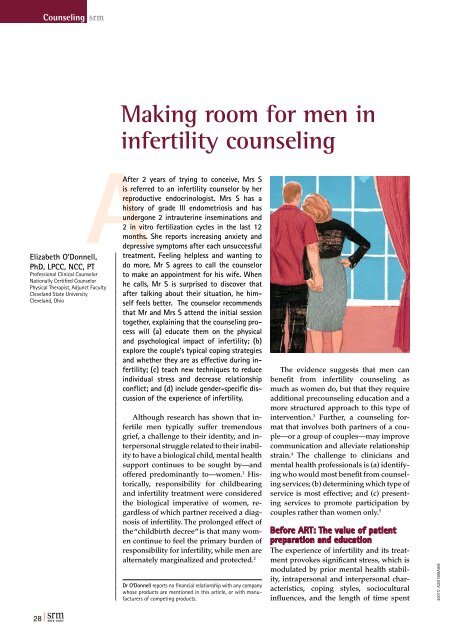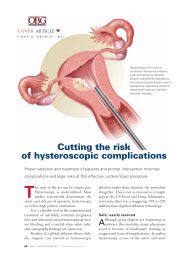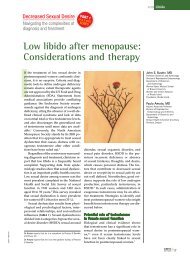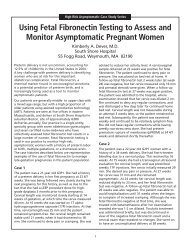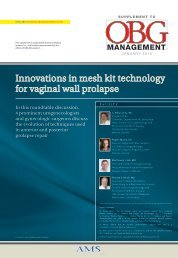Making room for men in infertility counseling - OBG Management
Making room for men in infertility counseling - OBG Management
Making room for men in infertility counseling - OBG Management
You also want an ePaper? Increase the reach of your titles
YUMPU automatically turns print PDFs into web optimized ePapers that Google loves.
28<br />
Counsel<strong>in</strong>g srm<br />
Elizabeth O’Donnell,<br />
PhD, LPCC, NCC, PT<br />
Professional Cl<strong>in</strong>ical Counselor<br />
Nationally Certified Counselor<br />
Physical Therapist, Adjunct Faculty<br />
Cleveland State University<br />
Cleveland, Ohio<br />
A<br />
<strong>Mak<strong>in</strong>g</strong> <strong>room</strong> <strong>for</strong> <strong>men</strong> <strong>in</strong><br />
<strong>in</strong>fertility counsel<strong>in</strong>g<br />
After 2 years of try<strong>in</strong>g to conceive, Mrs S<br />
is referred to an <strong>in</strong>fertility counselor by her<br />
reproductive endocr<strong>in</strong>ologist. Mrs S has a<br />
history of grade III endometriosis and has<br />
undergone 2 <strong>in</strong>trauter<strong>in</strong>e <strong>in</strong>sem<strong>in</strong>ations and<br />
2 <strong>in</strong> vitro fertilization cycles <strong>in</strong> the last 12<br />
months. She reports <strong>in</strong>creas<strong>in</strong>g anxiety and<br />
depressive symptoms after each unsuccessful<br />
treat<strong>men</strong>t. Feel<strong>in</strong>g helpless and want<strong>in</strong>g to<br />
do more, Mr S agrees to call the counselor<br />
to make an appo<strong>in</strong>t<strong>men</strong>t <strong>for</strong> his wife. When<br />
he calls, Mr S is surprised to discover that<br />
after talk<strong>in</strong>g about their situation, he himself<br />
feels better. The counselor recom<strong>men</strong>ds<br />
that Mr and Mrs S attend the <strong>in</strong>itial session<br />
together, expla<strong>in</strong><strong>in</strong>g that the counsel<strong>in</strong>g process<br />
will (a) educate them on the physical<br />
and psychological impact of <strong>in</strong>fertility; (b)<br />
explore the couple’s typical cop<strong>in</strong>g strategies<br />
and whether they are as effective dur<strong>in</strong>g <strong>in</strong>fertility;<br />
(c) teach new techniques to reduce<br />
<strong>in</strong>dividual stress and decrease relationship<br />
conflict; and (d) <strong>in</strong>clude gender-specific discussion<br />
of the experience of <strong>in</strong>fertility.<br />
Although research has shown that <strong>in</strong>fertile<br />
<strong>men</strong> typically suffer tre<strong>men</strong>dous<br />
grief, a challenge to their identity, and <strong>in</strong>terpersonal<br />
struggle related to their <strong>in</strong>ability<br />
to have a biological child, <strong>men</strong>tal health<br />
support cont<strong>in</strong>ues to be sought by—and<br />
offered predom<strong>in</strong>antly to—wo<strong>men</strong>. 1 Historically,<br />
responsibility <strong>for</strong> childbear<strong>in</strong>g<br />
and <strong>in</strong>fertility treat<strong>men</strong>t were considered<br />
the biological imperative of wo<strong>men</strong>, regardless<br />
of which partner received a diagnosis<br />
of <strong>in</strong>fertility. The prolonged effect of<br />
the “childbirth decree” is that many wo<strong>men</strong><br />
cont<strong>in</strong>ue to feel the primary burden of<br />
responsibility <strong>for</strong> <strong>in</strong>fertility, while <strong>men</strong> are<br />
alternately marg<strong>in</strong>alized and protected. 2<br />
Dr O’Donnell reports no f<strong>in</strong>ancial relationship with any company<br />
whose products are <strong>men</strong>tioned <strong>in</strong> this article, or with manufacturers<br />
of compet<strong>in</strong>g products.<br />
The evidence suggests that <strong>men</strong> can<br />
benefit from <strong>in</strong>fertility counsel<strong>in</strong>g as<br />
much as wo<strong>men</strong> do, but that they require<br />
additional precounsel<strong>in</strong>g education and a<br />
more structured approach to this type of<br />
<strong>in</strong>tervention. 3 Further, a counsel<strong>in</strong>g <strong>for</strong>mat<br />
that <strong>in</strong>volves both partners of a couple—or<br />
a group of couples—may improve<br />
communication and alleviate relationship<br />
stra<strong>in</strong>. 4 The challenge to cl<strong>in</strong>icians and<br />
<strong>men</strong>tal health professionals is (a) identify<strong>in</strong>g<br />
who would most benefit from counsel<strong>in</strong>g<br />
services; (b) determ<strong>in</strong><strong>in</strong>g which type of<br />
service is most effective; and (c) present<strong>in</strong>g<br />
services to promote participation by<br />
couples rather than wo<strong>men</strong> only. 5<br />
Be<strong>for</strong>e ART: The value of patient<br />
preparation and education<br />
The experience of <strong>in</strong>fertility and its treat<strong>men</strong>t<br />
provokes significant stress, which is<br />
modulated by prior <strong>men</strong>tal health stability,<br />
<strong>in</strong>trapersonal and <strong>in</strong>terpersonal characteristics,<br />
cop<strong>in</strong>g styles, sociocultural<br />
<strong>in</strong>fluences, and the length of time spent<br />
Alex NAbAUm<br />
2007©
try<strong>in</strong>g to conceive. Differences <strong>in</strong><br />
the way partners acknowledge<br />
and manage stress symptoms can<br />
stra<strong>in</strong> the relationship and add to<br />
the sense of helplessness many<br />
couples experience. 6<br />
Couples who are educated<br />
early <strong>in</strong> the treat<strong>men</strong>t process<br />
about what to expect, how best<br />
to support themselves and their<br />
partner, and where they can go<br />
<strong>for</strong> additional resources report<br />
feel<strong>in</strong>g better equipped to handle<br />
the emotional fallout of <strong>in</strong>fertility<br />
treat<strong>men</strong>t and possible treat<strong>men</strong>t<br />
failure. 7 Psychological distress<br />
cont<strong>in</strong>ues to be one of the ma<strong>in</strong><br />
reasons couples cite <strong>for</strong> discont<strong>in</strong>u<strong>in</strong>g<br />
treat<strong>men</strong>t; there<strong>for</strong>e, education<br />
and ef<strong>for</strong>ts to reduce distress have<br />
implications not only <strong>for</strong> patient well-be<strong>in</strong>g<br />
but also <strong>for</strong> patient retention. 7-9<br />
Wo<strong>men</strong> frequently attend their first<br />
consultative <strong>in</strong>fertility appo<strong>in</strong>t<strong>men</strong>t without<br />
their partner. Many <strong>men</strong> report that<br />
their <strong>in</strong>itial exposure to gynecological<br />
medic<strong>in</strong>e is as mysterious as their understand<strong>in</strong>g<br />
of <strong>men</strong>struation. They are neither<br />
prepared to know more nor com<strong>for</strong>table<br />
be<strong>in</strong>g asked to contribute beyond the <strong>in</strong>itial<br />
diagnostic sperm sample, and <strong>for</strong> many<br />
<strong>men</strong> this is where their desire <strong>for</strong> regular<br />
participation <strong>in</strong> <strong>in</strong>fertility treat<strong>men</strong>t is <strong>in</strong>cl<strong>in</strong>ed<br />
to stop. 10,11 Wo<strong>men</strong> describe feel<strong>in</strong>g<br />
<strong>in</strong>creas<strong>in</strong>gly isolated dur<strong>in</strong>g this period,<br />
los<strong>in</strong>g faith <strong>in</strong> their body and previously<br />
held beliefs about their life path, ability to<br />
be happy, and their relationship. 7<br />
When couples present <strong>for</strong> treat<strong>men</strong>t<br />
they are often unaware of the pervasive<br />
impact that assisted reproductive technologies<br />
(ART) can have on their lives.<br />
Although it might seem appropriate to<br />
describe <strong>in</strong>fertility as a “couple problem,”<br />
<strong>men</strong> and wo<strong>men</strong> generally experience<br />
treat<strong>men</strong>t as observer and participant,<br />
respectively. Studies demonstrat<strong>in</strong>g gender<br />
differences <strong>in</strong> response to fertility<br />
treat<strong>men</strong>t highlight the need to educate<br />
<strong>in</strong>dividuals about ways to traverse these<br />
differences 6,12 and, <strong>in</strong> fact, it is often lack<br />
of preparation—rather than unwill<strong>in</strong>gness—that<br />
<strong>in</strong>hibits the participation of<br />
the male partner.<br />
Evidence shows that <strong>men</strong> who receive<br />
pretreat<strong>men</strong>t educational brochures are<br />
more likely to attend <strong>in</strong>fertility appo<strong>in</strong>t-<br />
TABLE 1<br />
Fertility Problem Inventory<br />
Scale Sample State<strong>men</strong>ts<br />
Sexual concern I feel like I’ve failed at sex.<br />
Social concern I feel like friends or family<br />
are leav<strong>in</strong>g us beh<strong>in</strong>d.<br />
Relationship When we try to talk about<br />
concern our fertility problem, it seems<br />
to lead to an argu<strong>men</strong>t.<br />
Need <strong>for</strong> Hav<strong>in</strong>g a child is not<br />
parenthood necessary to my happ<strong>in</strong>ess.<br />
Rejection of a It’s hard to feel like a true<br />
child-free lifestyle adult until you have a child.<br />
Score elevations detected with this tool are helpful <strong>in</strong> identify<strong>in</strong>g elevated levels of<br />
<strong>in</strong>fertility-related stress and <strong>in</strong> discover<strong>in</strong>g areas of discrepancy between partners.<br />
Those differences are useful targets <strong>for</strong> education and counsel<strong>in</strong>g <strong>in</strong>tervention.<br />
Used with permission from Newton CR, et al. Fertil Steril. 1999;72:54-62.<br />
<strong>men</strong>ts than those who do not. 13 Along with<br />
cl<strong>in</strong>ical protocols, referral packets should<br />
<strong>in</strong>clude a description of available counsel<strong>in</strong>g<br />
services and an explanation of their<br />
potential benefits; literature that addresses<br />
the needs of couples as well as <strong>in</strong>dividuals<br />
may encourage the participation of both<br />
partners <strong>in</strong> counsel<strong>in</strong>g. F<strong>in</strong>ally, preappo<strong>in</strong>t<strong>men</strong>t<br />
telephone calls directed toward<br />
each partner establish the expectation that<br />
the consult is <strong>in</strong>tended <strong>for</strong> the couple rather<br />
than the woman only, thereby sett<strong>in</strong>g a<br />
precedent <strong>for</strong> follow-up visits.<br />
Strategies to successfully<br />
recom<strong>men</strong>d <strong>in</strong>tervention services<br />
A couple’s problem-solv<strong>in</strong>g skills might<br />
not be as effective as usual when deal<strong>in</strong>g<br />
with <strong>in</strong>fertility. It is possible that both fear<br />
and lack of “know how” <strong>in</strong> negotiat<strong>in</strong>g <strong>in</strong>fertility’s<br />
terra<strong>in</strong> underlie <strong>men</strong>’s frequent<br />
reticence to engage <strong>in</strong> medical treat<strong>men</strong>t<br />
or counsel<strong>in</strong>g: “I’m a guy, I don’t really<br />
know all the <strong>in</strong>s and outs of it—just fix it<br />
and get back to me.”<br />
Physicians can offer couples a renewed<br />
ability to successfully manage the impact<br />
of <strong>in</strong>fertility by referr<strong>in</strong>g them to resources<br />
that can teach new cop<strong>in</strong>g strategies,<br />
<strong>for</strong> example, listen<strong>in</strong>g to one’s partner<br />
express their concerns rather than immediately<br />
offer<strong>in</strong>g advice. In<strong>for</strong>mation<br />
can go a long way <strong>in</strong> eradicat<strong>in</strong>g fear and<br />
enabl<strong>in</strong>g patients to successfully address<br />
the impact of <strong>in</strong>fertility.<br />
The Fertility Problem Inventory (FPI)<br />
provides useful basel<strong>in</strong>e <strong>in</strong><strong>for</strong>mation <strong>for</strong><br />
evaluat<strong>in</strong>g the level of difficulty that a<br />
srm Counsel<strong>in</strong>g<br />
KeY Po<strong>in</strong>t<br />
Patient literature<br />
and preappo<strong>in</strong>t<strong>men</strong>t<br />
calls directed at both<br />
partners promotes<br />
couple participation<br />
<strong>in</strong> <strong>in</strong>fertility consults<br />
and counsel<strong>in</strong>g.<br />
29
Counsel<strong>in</strong>g srm<br />
KeY Po<strong>in</strong>t<br />
The Fertility Problem<br />
Inventory identifies<br />
the specific<br />
difficulties of<br />
an <strong>in</strong>fertile couple,<br />
facilitat<strong>in</strong>g referral<br />
to appropriate<br />
<strong>men</strong>tal health<br />
<strong>in</strong>terventions.<br />
30<br />
TABLE 2<br />
couple diagnosed with <strong>in</strong>fertility is experienc<strong>in</strong>g.<br />
14 This 46-item questionnaire<br />
measures perceived <strong>in</strong>fertility stress on a<br />
6-po<strong>in</strong>t Likert scale <strong>in</strong> 5 categories: sexual<br />
concern, social concern, relationship concern,<br />
need <strong>for</strong> parenthood, and rejection of<br />
a child-free lifestyle (TAble 1). The FPI also<br />
<strong>in</strong>cludes an overall global stress score.<br />
By highlight<strong>in</strong>g specific problem areas,<br />
the FPI may be used as a reference po<strong>in</strong>t<br />
<strong>for</strong> offer<strong>in</strong>g <strong>in</strong>terventions that match the<br />
stated difficulty. For example, couples<br />
<strong>for</strong> whom mutual support is a problem<br />
should be referred to programs that teach<br />
active listen<strong>in</strong>g skills. 14 Although the FPI<br />
was orig<strong>in</strong>ally designed <strong>for</strong> use by <strong>men</strong>tal<br />
health professionals, physicians may f<strong>in</strong>d<br />
the FPI helpful <strong>in</strong> promot<strong>in</strong>g discussion of<br />
sensitive topics such as loss of desire, per<strong>for</strong>mance<br />
anxiety, and sexual dysfunction.<br />
Couples fac<strong>in</strong>g reproductive challenges<br />
often report feel<strong>in</strong>g stigmatized by an<br />
“<strong>in</strong>visible shame.” 15 To dim<strong>in</strong>ish this effect,<br />
it is important that cl<strong>in</strong>icians m<strong>in</strong>imize the<br />
use of <strong>men</strong>tal health labels. Emotional<br />
descriptions such as feel<strong>in</strong>g sad or worried<br />
are more helpful to <strong>in</strong>fertile patients<br />
than cl<strong>in</strong>ical labels such as depression and<br />
anxiety. 7 These dist<strong>in</strong>ctions are important<br />
because patients’ perceptions of their<br />
emotions can drive the actions they are<br />
prepared to take to f<strong>in</strong>d help.<br />
Men <strong>in</strong> particular may <strong>in</strong>dicate that<br />
they believe they can overcome these<br />
feel<strong>in</strong>gs alone. 11 They report fear of be<strong>in</strong>g<br />
judged “deficient” and describe an unexpected<br />
burden at be<strong>in</strong>g unable to impreg-<br />
The Stages of Change Model<br />
Stages of Change Associated Change Processes Possible Interventions<br />
Precontemplation No perceived benefit to Shar<strong>in</strong>g evidence of benefit<br />
chang<strong>in</strong>g of education or counsel<strong>in</strong>g<br />
(suggested read<strong>in</strong>gs)<br />
Contemplation Assess<strong>in</strong>g impact of distress Review evidence of impact of<br />
on self and relationship <strong>in</strong>fertility on life and relationships<br />
Preparation Consider<strong>in</strong>g effect of Referral to resources, eg,<br />
counsel<strong>in</strong>g support <strong>in</strong>troductory psychoeducational<br />
sem<strong>in</strong>ar<br />
Action Participation <strong>in</strong> counsel<strong>in</strong>g Group workshop, sem<strong>in</strong>ar, or<br />
or supportive education couple counsel<strong>in</strong>g (cognitive<br />
behavioral or m<strong>in</strong>d-body)<br />
Ma<strong>in</strong>tenance Reliance on learned skills Ongo<strong>in</strong>g application of learned skills<br />
DiCle<strong>men</strong>te CC, Prochaska JO. In: Shiffman S, Willis TA, eds. Cop<strong>in</strong>g and Substance Abuse. San Diego, CA: Academic Press; 1985:319-334.<br />
nate their partner. Men may view shar<strong>in</strong>g<br />
their feel<strong>in</strong>gs about <strong>in</strong>fertility as a conversation<br />
taboo: “If I told her how upset I was<br />
about not hav<strong>in</strong>g kids…well, it would be<br />
like tell<strong>in</strong>g her she’s fat—it’s a card<strong>in</strong>al<br />
s<strong>in</strong>.” By discuss<strong>in</strong>g these feel<strong>in</strong>gs and assur<strong>in</strong>g<br />
patients that their reactions are<br />
not unusual, cl<strong>in</strong>icians can help alleviate<br />
a couple’s discom<strong>for</strong>t and facilitate open<br />
and honest discussion. 11<br />
What type of <strong>in</strong>tervention?<br />
The relation of stress to <strong>in</strong>fertility is<br />
long-stand<strong>in</strong>g and ambiguous. Credible<br />
evidence supports the connection<br />
between stress hormones and <strong>men</strong>strual<br />
dysfunction, but the precise mechanism<br />
of action of stress on fertility rema<strong>in</strong>s<br />
unclear. 16 Psychogenic <strong>in</strong>fertility 17,18 has<br />
fallen out of favor as an explanation <strong>for</strong><br />
<strong>in</strong>fertility, 19 plac<strong>in</strong>g a pall on the use of<br />
the word “stress” <strong>in</strong> association with reproduction.<br />
Some researchers have docu<strong>men</strong>ted<br />
a cl<strong>in</strong>ical relationship between<br />
trait versus episodic anxiety and depression<br />
rates <strong>in</strong> pregnancy outcome and <strong>in</strong><br />
vitro fertilization, while others demand<br />
caution <strong>in</strong> attribut<strong>in</strong>g a causal relationship<br />
between psychological characteristics<br />
and fertility. 20-22<br />
When referr<strong>in</strong>g patients <strong>for</strong> <strong>in</strong>fertility<br />
counsel<strong>in</strong>g, cl<strong>in</strong>icians can discuss how<br />
cognitive-behavioral and m<strong>in</strong>d-body<br />
approaches to <strong>men</strong>tal health treat<strong>men</strong>t<br />
have demonstrated a benefit to <strong>in</strong>dividuals<br />
and couples experienc<strong>in</strong>g <strong>in</strong>fertility.<br />
4,20,23 These <strong>in</strong>terventions are designed
to address the complex physiological<br />
variability that accompanies <strong>in</strong>fertility.<br />
They employ strategies that help to <strong>in</strong>terrupt<br />
excessive rum<strong>in</strong>ation or fatalistic<br />
th<strong>in</strong>k<strong>in</strong>g, aim to <strong>in</strong>still and ma<strong>in</strong>ta<strong>in</strong><br />
realistic hope, and assist participants<br />
<strong>in</strong> recogniz<strong>in</strong>g their own physical and<br />
emotional manifestations of stress.<br />
Meditative and body-awareness techniques,<br />
such as breath<strong>in</strong>g and progressive<br />
muscle relaxation, are used to<br />
facilitate greater identification between<br />
emotional distress and its impact on<br />
physical and physiological function. 24<br />
Men have reported us<strong>in</strong>g deep-breath<strong>in</strong>g<br />
techniques <strong>in</strong> particular to help<br />
slow their reaction time, decrease irritability,<br />
and reduce muscle tension<br />
dur<strong>in</strong>g periods of stress and emotional<br />
arousal from <strong>in</strong>fertility as well as other<br />
causes. 7<br />
More cost-effective than <strong>in</strong>dividual sessions,<br />
group <strong>in</strong>terventions offer the benefits<br />
of peer support, decreased isolation,<br />
collaborative shar<strong>in</strong>g, and an opportunity<br />
<strong>for</strong> role model<strong>in</strong>g or imitative learn<strong>in</strong>g<br />
among group members.<br />
Promot<strong>in</strong>g couple participation<br />
Psychoeducational <strong>in</strong>terventions that<br />
teach couples what to expect at the<br />
beg<strong>in</strong>n<strong>in</strong>g of treat<strong>men</strong>t and provide<br />
funda<strong>men</strong>tal strategies <strong>for</strong> cop<strong>in</strong>g are<br />
highly valuable; they help to improve<br />
and ma<strong>in</strong>ta<strong>in</strong> relationship <strong>in</strong>tegrity and<br />
equip couples with the communication<br />
skills to navigate unpredictable terra<strong>in</strong>. 4<br />
A recent research project designed to<br />
evaluate a 1-day m<strong>in</strong>d-body workshop<br />
<strong>for</strong> wo<strong>men</strong> and couples fac<strong>in</strong>g <strong>in</strong>fertility<br />
revealed an important difference <strong>in</strong> several<br />
parameters between wo<strong>men</strong> who<br />
attended the workshop alone and wo<strong>men</strong><br />
who attended as part of a couple.<br />
Couples who attended together reported<br />
higher levels of relationship conflict<br />
pre-workshop and improved <strong>in</strong>terpersonal<br />
communication post-workshop;<br />
they were more likely to be us<strong>in</strong>g m<strong>in</strong>dbody<br />
techniques a year later; and they<br />
had higher pregnancy and live birth<br />
rates. 7 Although this study was not large<br />
enough to suggest a cause-and-effect<br />
conclusion about the effect of <strong>in</strong>dividual<br />
versus couple participation, it does support<br />
the need to look more closely at this<br />
variable <strong>in</strong> treat<strong>men</strong>t outcome.<br />
Engag<strong>in</strong>g <strong>men</strong> <strong>in</strong> counsel<strong>in</strong>g<br />
Mental health outreach directed toward<br />
<strong>men</strong> is a severely neglected field. 25 Men<br />
are usually not socialized to seek professional<br />
help <strong>for</strong> emotional difficulties, and<br />
they tend to be particularly resistant to<br />
group activities that attempt to address<br />
<strong>men</strong>tal health issues. With escalat<strong>in</strong>g<br />
treat<strong>men</strong>t costs and a dim<strong>in</strong>ished ability<br />
to predict whether the physical and emotional<br />
<strong>in</strong>vest<strong>men</strong>t will guarantee a successful<br />
pregnancy, couples—and <strong>men</strong> <strong>in</strong><br />
particular—tend to ask how a given <strong>in</strong>tervention<br />
might contribute to achiev<strong>in</strong>g a<br />
viable pregnancy. This is especially true of<br />
counsel<strong>in</strong>g, which is viewed by many <strong>men</strong><br />
as <strong>in</strong>effective, a sign of personal weakness,<br />
or simply, an elusive commodity. 5,25<br />
When assess<strong>in</strong>g the read<strong>in</strong>ess level of<br />
<strong>in</strong>dividuals to accept <strong>men</strong>tal health <strong>in</strong>terventions,<br />
physicians may f<strong>in</strong>d it helpful to<br />
keep <strong>in</strong> m<strong>in</strong>d the Stages of Change Model<br />
(TAble 2). 26 It is likely that wo<strong>men</strong> and<br />
<strong>men</strong> arrive at these stages at different<br />
po<strong>in</strong>ts dur<strong>in</strong>g their <strong>in</strong>fertility experience.<br />
Typically, patients <strong>in</strong> a precontemplative<br />
stage of change will see less benefit<br />
to counsel<strong>in</strong>g than someone who is at a<br />
later stage <strong>in</strong> their desire to trans<strong>for</strong>m<br />
behavior. Wo<strong>men</strong>, who typically struggle<br />
with <strong>in</strong>tervention schedules and medication<br />
protocols, may feel that they live<br />
with their body under a <strong>for</strong>m of cont<strong>in</strong>ual<br />
physical and emotional siege. They are<br />
far more likely than their male partner<br />
to discuss their difficulties with other<br />
wo<strong>men</strong>, friends, and relatives, and they<br />
may more readily perceive counsel<strong>in</strong>g as<br />
a part of the support they need. 4<br />
It may be possible to <strong>in</strong>fluence <strong>men</strong><br />
to participate <strong>in</strong> seek<strong>in</strong>g <strong>men</strong>tal health<br />
support earlier <strong>in</strong> the course of ART<br />
treat<strong>men</strong>t by provid<strong>in</strong>g patient handouts<br />
with prom<strong>in</strong>ent testimonials from<br />
<strong>men</strong> that convey the experience of <strong>in</strong>fertility<br />
<strong>in</strong> a way with which male patients<br />
can identify. Men who have benefited<br />
from this type of service report a will<strong>in</strong>gness<br />
to share their <strong>in</strong>sights with other<br />
<strong>men</strong> who are consider<strong>in</strong>g participation<br />
(sidebAr). 7<br />
Conclusion<br />
After attend<strong>in</strong>g counsel<strong>in</strong>g with his wife,<br />
Mr S reports that he is better able to understand<br />
how ART is affect<strong>in</strong>g her, both<br />
physically and emotionally. He has also<br />
srm Counsel<strong>in</strong>g<br />
KeY Po<strong>in</strong>t<br />
Body-awareness<br />
techniques focus<br />
patients on the<br />
connection between<br />
their stress and<br />
physiological<br />
function.<br />
31
Counsel<strong>in</strong>g srm<br />
KeY Po<strong>in</strong>t<br />
Testimonials that<br />
reflect typical male<br />
concerns about<br />
counsel<strong>in</strong>g may<br />
encourage <strong>men</strong><br />
to seek <strong>men</strong>tal<br />
health support.<br />
32<br />
In Their Own Words<br />
A woman’s testimonial<br />
I know I need to get the emotional support first. my<br />
heart has been broken....I learned through the workshop<br />
is that <strong>in</strong>fertility is griev<strong>in</strong>g. I don’t believe anybody<br />
who already has a child could ever understand<br />
not hav<strong>in</strong>g a child. I mean, my husband sees the sadness<br />
<strong>in</strong> me but he doesn’t know what to say. Work is<br />
ta<strong>in</strong>ted beyond belief because I have had to tell people.<br />
I could have made up some other health problem, but<br />
people know about my <strong>in</strong>fertility, people I never wanted<br />
to know. I feel so violated that I despise them. I feel<br />
embarrassed to go to work. —Hillary<br />
ga<strong>in</strong>ed new awareness of how ART has affected<br />
him. Because Mr and Mrs S attended<br />
a group therapy session, he was reassured to<br />
see that their <strong>in</strong>terpersonal difficulties were<br />
not unusual. Mr S says, “I felt when we left<br />
the workshop, we left with someth<strong>in</strong>g else.”<br />
It is possible to successfully support a<br />
woman or couple through <strong>in</strong>fertility even if<br />
they do not achieve pregnancy. Future research<br />
will better expla<strong>in</strong> the stress effects<br />
of <strong>in</strong>fertility and provide evidence-based<br />
protocols that are more directly l<strong>in</strong>ked to<br />
pregnancy outcome. Until that time, cl<strong>in</strong>icians<br />
should be aware of the research that<br />
does demonstrate the significant psychological<br />
and relationship stra<strong>in</strong> that can<br />
result from <strong>in</strong>fertility and consider the potential<br />
added benefit to medical treat<strong>men</strong>t<br />
that <strong>men</strong>tal health support can provide. n<br />
References<br />
1. Gannon K, Glover L, Abel P. Mascul<strong>in</strong>ity, <strong>in</strong>fertility, stigma and media reports.<br />
Soc Sci Med. 2004;59:1169-1175.<br />
2. Pfeffer N. The Stork and the Syr<strong>in</strong>ge: A Political History of Reproductive<br />
Medic<strong>in</strong>e. Cambridge, UK: Polity Press; 1993.<br />
3. Ogrodniczuk JS. Men, wo<strong>men</strong>, and their outcome <strong>in</strong> psychotherapy.<br />
Psychotherapy Res. 2006;16:453-462.<br />
4. Schmidt L, Tjornhoj-Thomsen T, Boiv<strong>in</strong> J, Nyboe Andersen A. Evaluation<br />
of a communication and stress manage<strong>men</strong>t tra<strong>in</strong><strong>in</strong>g programme <strong>for</strong><br />
<strong>in</strong>fertile couples. Patient Educ Couns. 2005;59:252-262.<br />
5. Englar-Carlson M, Shepard DS. Engag<strong>in</strong>g <strong>men</strong> <strong>in</strong> couples counsel<strong>in</strong>g:<br />
Strategies <strong>for</strong> overcom<strong>in</strong>g ambivalence and <strong>in</strong>expressiveness. Fam J:<br />
Counsel Ther Couples Fam. 2005;13:383-391.<br />
6. Petersen BD, Newton CR, Rosen KH, Schulman RS. Cop<strong>in</strong>g processes of<br />
couples experienc<strong>in</strong>g <strong>in</strong>fertility. Fam Relat. 2006;55:227-239.<br />
7. O'Donnell E. Fac<strong>in</strong>g <strong>in</strong>fertility: Design and evaluation of a m<strong>in</strong>d-body<br />
program <strong>for</strong> provid<strong>in</strong>g effective emotional support [dissertation—mixed<br />
method, pilot study]. Cleveland, OH: Urban Education, Cleveland State<br />
University; 2006.<br />
Testimonials from <strong>men</strong> <strong>in</strong> counsel<strong>in</strong>g<br />
I was look<strong>in</strong>g <strong>for</strong> an answer or a solution when I first<br />
came. I was really judg<strong>men</strong>tal, like, “How are they go<strong>in</strong>g<br />
to help me with my problem?” I saw by the end of<br />
the class it is not just me—it’s lots of people who have<br />
the same problem….After the workshop, I have opened<br />
up more, talked to people about it. —Howard<br />
The experience was eye-open<strong>in</strong>g...hear<strong>in</strong>g other people’s<br />
perspectives on what they were go<strong>in</strong>g through, how they<br />
handled it. Pick<strong>in</strong>g up a new method to deal with it was<br />
good. When you start fac<strong>in</strong>g <strong>in</strong>fertility, you are try<strong>in</strong>g to<br />
tackle a problem and may not be do<strong>in</strong>g it well. —Graham<br />
8. Domar AD. Impact of psychological factors on drop out rates <strong>in</strong> <strong>in</strong>sured<br />
<strong>in</strong>fertility patients. Fertil Steril. 2004;81:271-273.<br />
9. Rajkhowa M, Mcconnell A, Thomas GE. Reasons <strong>for</strong> discont<strong>in</strong>uation<br />
of IVF treat<strong>men</strong>t: A questionnaire study. Hum Reprod. 2006;21:358-<br />
363.<br />
10. Throsby K, Gill R. It's different <strong>for</strong> <strong>men</strong>: Mascul<strong>in</strong>ity and IVF. Men<br />
Mascul<strong>in</strong>ities. 2004;6:330-348.<br />
11. O'Donnell E. Hear<strong>in</strong>g his voice: Men's experience with <strong>in</strong>fertility.<br />
Cleveland State University; 2005:1-62.<br />
12. M<strong>in</strong>des EJ, Ingram KM, Kliewer W, James CA. Longitud<strong>in</strong>al analyses of<br />
the relationship between unsupportive social <strong>in</strong>teractions and psychological<br />
adjust<strong>men</strong>t among wo<strong>men</strong> with fertility problems. Soc Sci<br />
Med. 2003;56:2165-2180.<br />
13. Pook M, Krause W. Stress reduction <strong>in</strong> male <strong>in</strong>fertility patients: A randomized,<br />
controlled trial. Fertil Steril. 2005;83:68-73.<br />
14. Newton CR, Sherrard W, Glavac I. The fertility problem <strong>in</strong>ventory:<br />
Measur<strong>in</strong>g perceived <strong>in</strong>fertility-related stress. Fertil Steril.<br />
1999;72:54-62.<br />
15. White<strong>for</strong>d LM, Gonzalez L. Stigma: The hidden burden of <strong>in</strong>fertility.<br />
Soc Sci Med. 1995;40:27-36.<br />
16. Wilson JF, Kopitzke EJ. Stress and <strong>in</strong>fertility. Curr Wo<strong>men</strong> Health Rep.<br />
2002;2:194-199.<br />
17. Benedek T. Infertility as a psychosomatic defense. Fertil Steril.<br />
1952;3:527-541.<br />
18. Bickers W. Uter<strong>in</strong>e contraction patterns: Effects of psychic stimuli on<br />
the myometrium. Fertil Steril. 1956;7:268-275.<br />
19. Wischmann TH. Psychogenic <strong>in</strong>fertility—Myths and facts. J Assist Reprod<br />
Genet. 2003;20:485-494.<br />
20. Domar AD, Friedman R, Zuttermeister PC. Distress and conception<br />
<strong>in</strong> <strong>in</strong>fertile wo<strong>men</strong>: A comple<strong>men</strong>tary approach. J Am Med Wo<strong>men</strong>s<br />
Assoc. 1999;54:196-199.<br />
21. Eugster A, V<strong>in</strong>gerhoets AJJM, van Heck GL, Merkus JMWM. The effects<br />
of episodic anxiety on an <strong>in</strong> vitro fertilization and <strong>in</strong>tracytoplasmic<br />
sperm <strong>in</strong>jection treat<strong>men</strong>t outcome: A pilot study. J Psychosom<br />
Obstet Gynaecol. 2004;25:57-65.<br />
22. Pook M, Tuschen-Caffier B, Kubek J, Schill WB, Krause W. Personality,<br />
cop<strong>in</strong>g and sperm count. Andrologia. 2005;37:29-35.<br />
23. Tarabusi M, Volpe A, Facch<strong>in</strong>etti F. Psychological group support attenuates<br />
distress of wait<strong>in</strong>g <strong>in</strong> couples scheduled <strong>for</strong> assisted reproduction.<br />
J Psychosom Obstet Gynaecol. 2004;25:273-279.<br />
24. Gard G. Are emotions important <strong>for</strong> good <strong>in</strong>teraction <strong>in</strong> treat<strong>men</strong>t<br />
situations? Physiotherapy Treat Pract. 2004;20:107-119.<br />
25. Rochlen AB, Hoyer WD. Market<strong>in</strong>g <strong>men</strong>tal health to <strong>men</strong>: Theoretical<br />
and practical considerations. J Cl<strong>in</strong> Psych. 2005;61:675-684.<br />
26. DiCle<strong>men</strong>te CC, Prochaska JO. Processes and stages of change: Cop<strong>in</strong>g<br />
and competence <strong>in</strong> smok<strong>in</strong>g behavior change. In: Shiffman S,<br />
Willis TA, eds. Cop<strong>in</strong>g and Substance Abuse. San Diego, CA: Academic<br />
Press; 1985:319–334.


